Windows Server 2019 and Dedupe
Note:I translated Japanese into English using Google Translate.
Thank you, Google.
There is a great article called “Windows Server Data Dedupliction and Forensic Analysis”.
If you are interested in the Dedupliction feature, I recommend that you read it first.
---
I used Windows Server 2019 and enabled the Data Deduplication function on volume F :.
Day 0 is set so that deduplication is performed immediately.
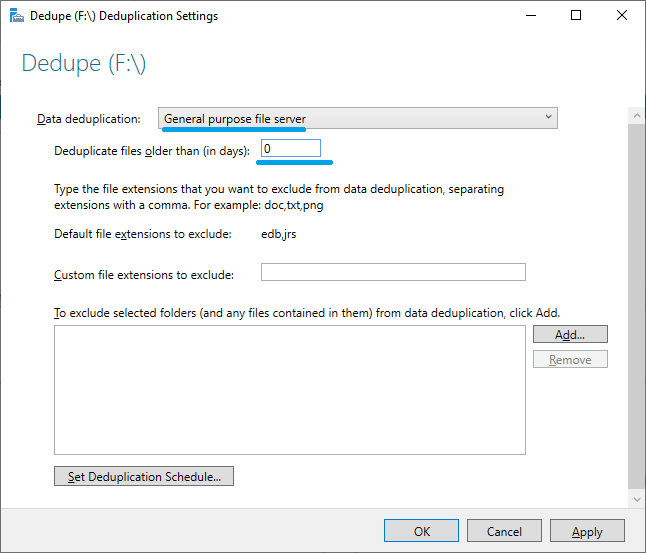
Two folders were created and several JPEG files were placed in each folder. I copied the same JPEG file, so these files should be deduplicated.


Check the deduplication status. None of the files have been deduplicated yet.

Use the Start-DedupJob command to execute deduplication.
Start-DedupJob -Type Optimization -Volume F: -Memory 100 -Cores 100 -Priority High

Ten files have been deduplicated.

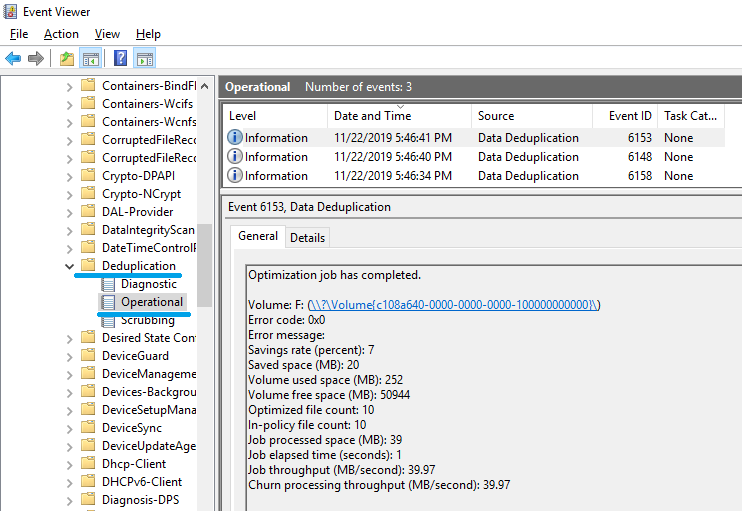
Use Windows Explorer to display the file properties. You can see that the size on the disk is zero.

The file attribute is "AL". “L” means Reparse Point. By looking at the “size on disk” or “attribute” in Windows Explorer, I can find a deduplicated file.

Let's check the attributes of the FILE record using Autopsy 4.13.0.

The staring address of $DATA attribute is “X” and "Sparse". The length is 980.
Check the FILE record of the JPEG file using FTK Imager. The value of DataRun is “02E003”. 0x03E0 ⇒ 992
Why doesn't the length match the Autopsy result?

Check "$REPARSE_POINT (0xC0)". This attribute is Non-Resident, and the attribute data is stored in cluster number 49662.

Refer to cluster number 49662. The first 4 bytes are “Reparse Type” and the value of “IO_REPARSE_TAG_DEDUP” is “0x80000013”.

Unfortunately, I couldn't find any information about the structure of IO_REPARSE_TAG_DEDUP.
Let's check the USN Journal using another file.
I prepared two images and deduplicated them.

Parse $J. And I discover that I misspelled "Koala" :-)

Finally, delete one of the deduplicated files.

Check the attributes in the FILE record of the deleted file.

Try to deduplicate the “Koala” image again.


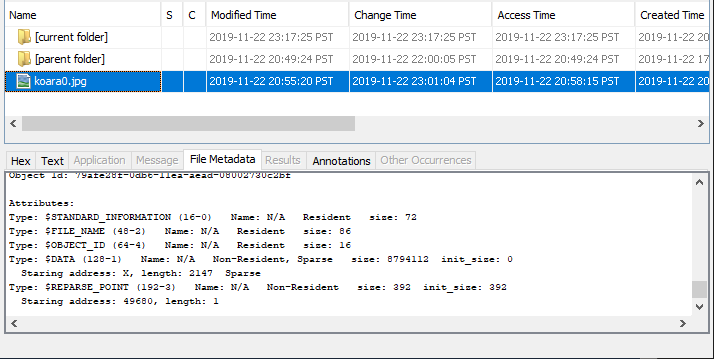
There was no change in the deduplication status of "Koala".
Verification environment: Windows Server 2019 1809.

Reference URL:

Microsoft-Windows-TerminalServices-RDPClient and NLA
Note:I translated Japanese into English using Google Translate.
Thank you, Google.
"Microsoft-Windows-Terminal Services-RDPClient / Operational" may record information to help you track Lateral Movement.
- Destination computer name / IP address, and Domain Name
- Username (encoded, so you need to find a matching username)
- Reason code that disconnected the session
Let's see what kind of information is recorded in this event log.
-(1)-
Displays the properties of "Microsoft-Windows-TerminalServices-RDPClient/Operational" on Windows 10 1809. In my test environment, logging was enabled by default.
There is no record at the time of OS installation.

Start mstsc.exe and connect to DC1. There is no option specified. (NLA is enabled on DC1.)

When Alice successfully logged on to DC1(192.168.100.100), nine events were recorded.

ID 1024
RDP ClientActiveX is trying to connect to the server (dc1)
In this event, you can check the computer name of the RDP connection destination "DC1". When an IP address is specified for Computer of MSTSC, the IP address is displayed.
ID 1028
Server supports SSL = supported
ID 1029
Base64(SHA256(UserName)) is = 37b1Qe+C6RABWfEqhOY11NzgSzEATQWYD8PK6fWhlzc=-
The username is encoded. The article "Windows Event ID 1029 Hashes" is a good reference for finding a matching username.
If you convert the username "alice" in CyberChef, you can see the same value as the event log.
If "example\alice" is specified for the user name, the domain name and user name are encoded in the event log.
Base64(SHA256(UserName)) is = LZDrhy6nd9yShjFabAXdEq4o+LXDgDsQAAsbbZEr2/0=-37b1Qe+C6RABWfEqhOY11NzgSzEATQWYD8PK6fWhlzc=
ID 1102
The client has initiated a multi-transport connection to the server 192.168.100.100.
In this event, you can check the IP address of DC1(192.168.100.100).
ID 1103
The client has established a multi-transport connection to the server.
ID 1025
RDP ClientActiveX has connected to the server
ID 1402
The client is using hardware memory for the frame buffer.
ID 1404
The server is using version 0xA0600 of the RDP graphics protocol (client mode: 0, AVC available: 1).
ID 1027
Connected to domain (EXAMPLE) with session 2.
In this event, you can check the domain name (EXAMPLE.LOCAL).
-(2)-
When Alice signed out of DC1, three events were recorded.

ID 226
RDPClient_SSL: An error was encountered when transitioning from TsSslStateDisconnected to TsSslStateDisconnected in response to TsSslEventInvalidState (error code 0x8000FFFF).
ID 1105
The multi-transport connection has been disconnected.
By linking this event with ID 1103, can I find out how long Alice has been connected via RDP?
ID 1026
RDP ClientActiveX has been disconnected (Reason= 2)
According to Technet's article, Reason code 2 is "User-initiated client logoff."
-(3)-
Check the event when authentication fails at NLA stage. Several events have been recorded, you can see that there is no ID 1103.

ID 1026
RDP ClientActiveX has been disconnected (Reason= 7943)
"Reason = 7943" is displayed as the disconnection reason, the corresponding article was not found in the article of TechNet.
-(4)-
Disable NLA in the RDP settings of DC1. Also, add the following to the .RDP file and turn off NLA.
enablecredsspsupport:i:0
Connected to RDP with NLA off.

Check the event log with the password input failure several times and the connection disconnected. (Alice has not logged on successfully.)

Event ID 1103 can confirm that the RDP connection is successful, but you need to confirm in the security log that the logon was successful.
If NLA is disabled, it will appear to be disconnected once. The reason code for disconnection is 263, but this is also a code that is not described in Technet.

Event ID 1029 displays the user name set in the RDP file.
After successfully connecting the RDP session, ID 1029 was not recorded again when another user name was entered.
If NLA is disabled and logon is successful, ID 1027 will be recorded.
If you can not check the security log, event ID 1027 may be a hint of successful logon. (Unfortunately, the successful logon username can not be verified from Event ID 1027.)

Verification environment: Windows Server 2019 1809, Windows 10 1809, Time zone UTC
Reference URL:

Windows Defender Remote Credential Guard and RestrictedAdmin mode.
Note:I translated Japanese into English using Google Translate.
Thank you, Google.
Windows Defender Remote Credential Guard is available for Windows 10 and Windows Server 2016.
Is there any way to check if Remote Credential Guard was used with RDP connection?
I checked some event logs but could not identify the use of /remoteGuard.
Remote Credential Guard needs to enable RestrictedAdmin mode. I'm concerned about enabling RestrictedAdmin mode. ->
「Passing the hash with native RDP client (mstsc.exe) - Blog | Michael Eder」
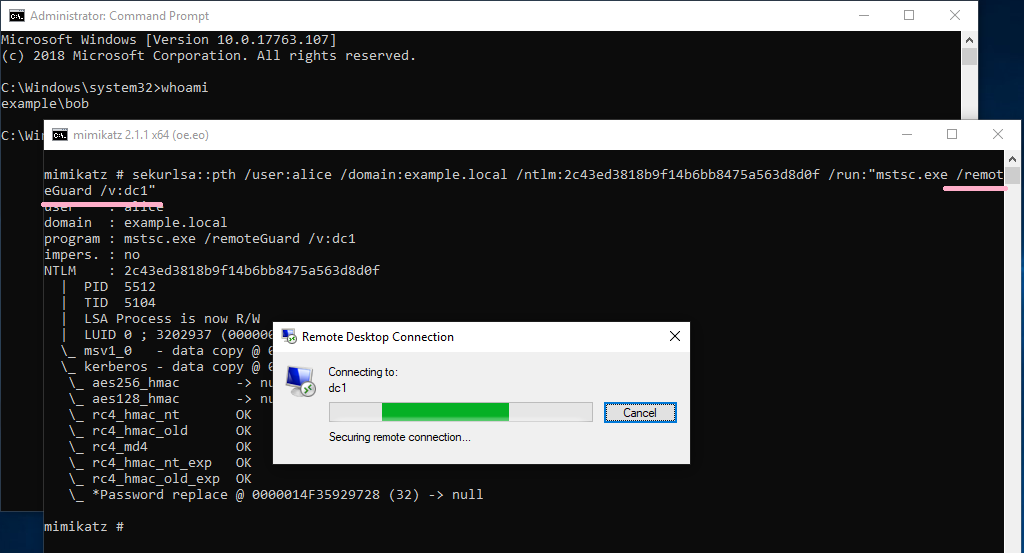
So I continue to look for information to identify.
---
I enabled RDP on Windows Server 2016 and NLA option is checked. The domain user Alice has been added to Remote Desktop Users.
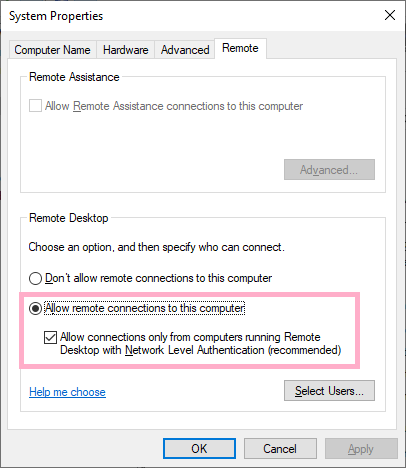
Set the DisableRestrictedAdmin value in the registry and enable RestrictedAdmin mode.

Execute mstsc.exe on Windows 10(PC1) with /remoteGuard option. This verification did not set up a group policy.
mstsc.exe /remoteGuard
If I enter a computer name, the user's item will be grayed out automatically.
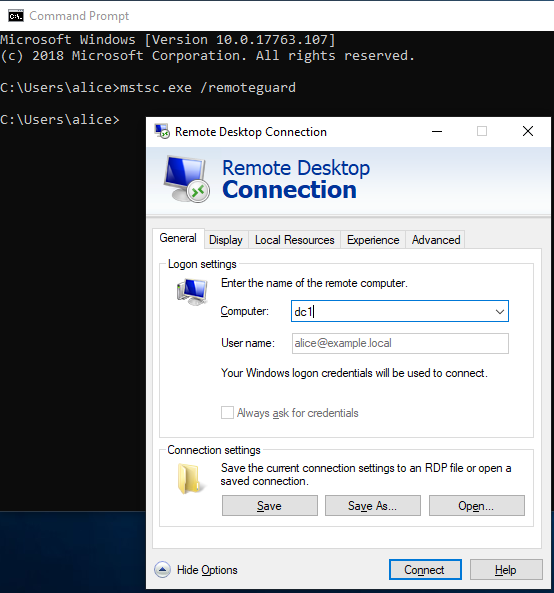
Connect to computer DC1 and view the event log.
DC1
Check the event log records. The following is event logs of DC1 which received RDP connection.
(1) ID 1149 does not record user names, but ID 21 and 22 record Alice.
2019-05-01T10:38:29.350975900Z Microsoft-Windows-TerminalServices-RemoteConnectionManager
ID 1149
Remote Desktop Services: User authentication succeeded:
User:
Domain:
Source Network Address: 192.168.100.10
2019-05-01T10:38:32.690529600Z Microsoft-Windows-TerminalServices-LocalSessionManager
ID 21
Remote Desktop Services: Session logon succeeded:
User: EXAMPLE\alice
Session ID: 2
Source Network Address: 192.168.100.10
ID 22
Remote Desktop Services: Shell start notification received:
User: EXAMPLE\alice
Session ID: 2
Source Network Address: 192.168.100.10
(2) Let's check the security log.
Check NLA event ID 4624 Logon type 3. The item of "Restricted Admin Mode:" is displayed as "-".

(3) Event ID 4648

(4) Event ID 4624 Logon Type 10, "Restricted Admin mode" is displayed as "NO".

I could not determine from the event log whether /remoteGuard was used.
Next, check the log when logged on in RestrictedAdmin mode.

It can be confirmed by the record of ID 4624 logon Type 10, "Restricted Admin mode" is displayed as "Yes".

PC1
If /remoteGuard or /restrictedAdmin is specified as an option of mstsc.exe, ID 4648 is not recorded in the security log.
Verification environment: Windows Server 2019 1809, Windows 10 1809, Time zone UTC
Reference URL:
#mimikatz can pass-the-ticket (Kerberos) for RDP with "restrictedadmin" support - protected users, you're welcome! pic.twitter.com/PBoUAjvki3
— 🥝 Benjamin Delpy (@gentilkiwi) March 1, 2014

AD ACL and ADTimeline
Note:I translated Japanese into English using Google Translate.
Thank you, Google.
Change the ACL of the object on AD and check ADTimline. Use AD ACL Scanner as a tool to check the ACL of AD objects.
AD Timeline-FIRST TC Page 22 has an entry for "AD replication metadata vs security event logs". Check the ACL and compare the security log.
Allow the Alice account the rights needed by DCsync. Below, I set up two permissions related to replication.

Two event ID 5136 were recorded in the security log.
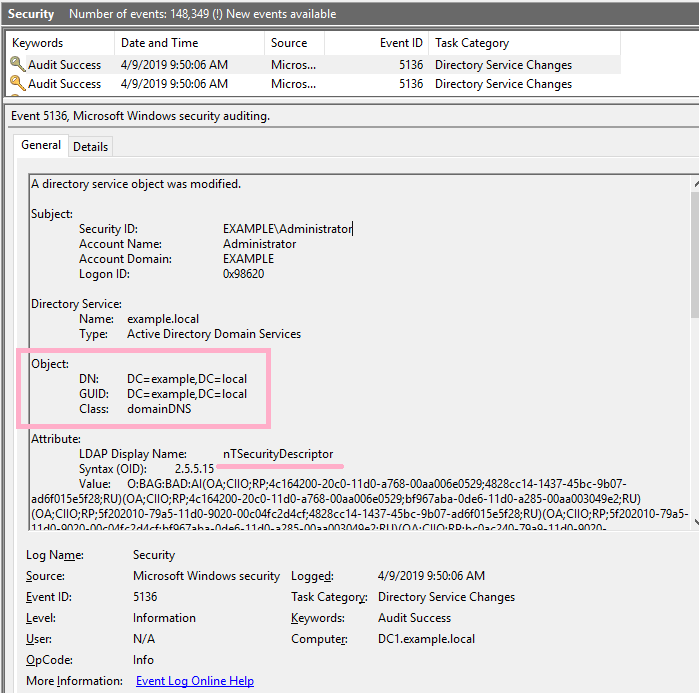
Run AD ACL Scanner and check the report. I can view the privileges of Alice account.
Two entries, Critical and Warning, are displayed.

Execute ADTimeline and check "nTSecurityDescriptor". The time is slightly different from security log ID 5136.

Remove the access rights of Alice account and view the timeline in ADTimeline.


On the timeline, the time stamp where I added Alice disappears, and a record of the time stamp where Alice was deleted is displayed.
Interesting :-)
Next, let's change the GPO ACL. Add an Alice account to Delegation.
Default Domain Policy: {31B2F340-016D-11D2-945F-00C04FB984F9}

Event ID 4662 is recorded in the security log. Two more ID 5136 records are recorded.


Check the ACL of Default Domain Policy {31B2F340-016D-11D2-945F-00C04FB984F9}. I can discover the privileges of Alice account.

Check the timeline. The timestamp is the same as event ID 4662.
Remove the access rights of Alice account that I added earlier from the GPO.

In the security log, ID 4662 and ID 5136 are recorded.

Create a timeline and compare it with the timestamps in the security log.

Next, allow AdminSDHolder full control of Bob's account. (This change is the result of a previous test with DCshadow.)
This setting allows access by Bob account to Domain Admins group etc.

Let's check the ACL. The report shows that Bob's account has full control.

Execute ADTimeline and search AdminSDHolder to find out the following events.
ftimeLastOriginatingChange : 2019-04-08T11:28:47Z
Name : AdminSDHolder
pszAttributeName : nTSecurityDescriptor
ObjectClass : container
DN : CN=AdminSDHolder,CN=System,DC=example,DC=local
ObjectCategory : CN=Container,CN=Schema,CN=Configuration,DC=example,DC=local
SamAccountName :
dwVersion : 4
WhenCreated : 2019-01-20 19:19:55Z
Member :
ftimeCreated :
ftimeDeleted :
SID :
pszLastOriginatingDsaDN : CN=NTDS Settings,CN=DC1,CN=Servers,CN=Default-First-Site-Name,CN=Sites,CN=Configur
ation,DC=example,DC=local
uuidLastOriginatingDsaInvocationID : c9e22352-ca47-436a-aeb2-38228298896d
usnOriginatingChange : 114772
usnLocalChange : 114772
Next,
Change the security of Bob account. Change Owner to Bob and set Deny to Everyone.

If try to view Bob's account security information, it will be denied.

Scan the ACL again and view the report. I can see the permissions granted to Bob account, but the report does not include information about the Bob account itself.


Reference URL:
An ACE Up the Sleeve:Designing Active Directory DACL Backdoors
https://specterops.io/assets/resources/an_ace_up_the_sleeve.pdf

RDP NLA and ID 4624 Logon Type3
Note:I translated Japanese into English using Google Translate.
Thank you, Google.
If NLA(Network Level Authentication) is enabled for RDP connection, event ID 4624 logon type 3 will be recorded in the security log.
Is there a way to determine the event ID 4624 logon type 3 recorded by NLA?
----------
Configure RDP in a test environment (Windows 10). Enable NLA in RDP settings.

Connect to Windows 10 with MSTSC.EXE. Certification is required by NLA.

Event ID 4624 Logon Type 3 is recorded in the security log when I enter the correct authentication information.

Event ID 4624 Logon Type 10 was recorded as the RDP connection was successful.
My question is, can I link this event to the NLA event ID 4624 Logon Type 3 record?
Unfortunately, Logon ID can not connect two events.
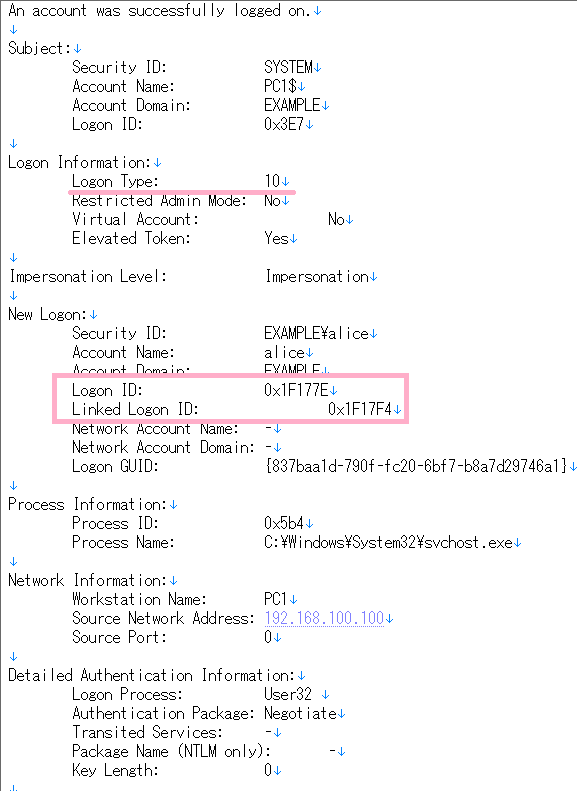
Let's check the event log related to RDP.
ID 1149 is recorded at a very similar time to "ID 4624 logonType 3".

Arrange three events in time order. Although the timestamps do not match exactly, I can confirm that they are very close values.
2019-04-07T10:17:12.733209800Z ID 4624 Logon Type 3
2019-04-07T10:17:12.742504600Z ID 1149 Remote Desktop Services: User authentication succeeded:
2019-04-07T10:17:14.815911800Z ID 4624 Logon Type 10
Is there any information that links ID 1149 other than time stamp? I tried to compare the Correlation values, but this is not the same.
ID 4624 Logon Type 3:
Correlation
[ ActivityID] {31290b36-ed74-0000-4d0c-293174edd401}ID 1149
Correlation
[ ActivityID] {f4208d55-a62e-41d8-a71b-58a083da0000}
Let's include the log of "Microsoft-Windows-TerminalServices-LocalSessionManager".
2019-04-07T10:17:12.733209800Z ID 4624 Logon Type 3
2019-04-07T10:17:12.742504600Z ID 1149 Remote Desktop Services: User authentication succeeded:
2019-04-07T10:17:14.815911800Z ID 4624 Logon Type 10
2019-04-07T10:17:14.859104600Z ID 41 Begin session arbitration:
2019-04-07T10:17:18.317919800Z ID 42 End session arbitration:
2019-04-07T10:17:20.549253300Z ID 21 Remote Desktop Services: Session logon succeeded:
When I sign out of RDP, Event ID 4634 logon type 3 is recorded. You can associate the ID 4624 with the Logon ID value(0x1E98FF).

Let's arrange the log of "Microsoft-Windows-TerminalServices-LocalSessionManager" and ID 4634 in order of time.
2019-04-07T11:29:28.977682900Z ID 4647 User initiated logoff:
2019-04-07T11:29:29.028431800Z ID 23 Remote Desktop Services: Session logoff succeeded:
2019-04-07T11:29:29.396625500Z ID 40 Session 2 has been disconnected, reason code 12
2019-04-07T11:29:29.474687900Z ID 4634 An account was logged off.
2019-04-07T11:29:29.486780000Z ID 24 Remote Desktop Services: Session has been disconnected:
Is it a good idea to link ID 24 and ID 4634 with a timestamp and search for ID 4624 by Logon ID?
Reference URL:

RDP and ID 1149 "Remote Desktop Services: User authentication succeeded:"
Note:I translated Japanese into English using Google Translate.
Thank you, Google.
Summary:
- Windows 10: ID 1149 is recorded when Alice's account is successfully logged on via RDP.
- Windows 10: If you specify the RestrictedAdmin option, the username and domain will be blank.
- Windows 10: If you turn off NLA and log on with Rdesktop, ID 1149 will not be recorded.
----------
What kind of user operation is event ID 1149 recorded? Let's check the record in Windows 10 environment.
Enable Remote Desktop on Windows 10 (1809). NLA is ON.

Start "mstsc.exe" on Windows Server 2019. IP address is specified as the connection destination.

If the Alice account is successfully logged on, ID 1149 is recorded in "Microsoft-Windows-TerminalServices-RemoteConnectionManager/Operational".
The ID 1149 is not recorded if the authentication fails, such as the user has made a mistake in the password.

Disconnect RDP connection and connect again.ID 1149 is recorded.
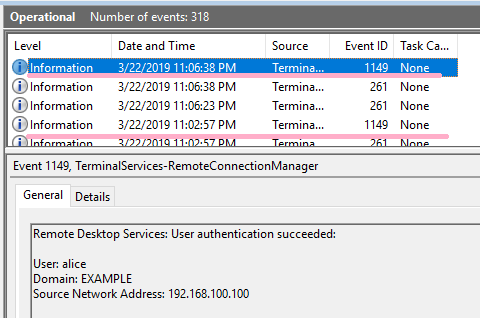
Use Remmina as an RDP client. If logon is successful, ID 1149 is recorded.


Executed with the /restrictedadmin option specified in mstsc. (I have changed the registry settings and enabled RestrictedAdmin mode.)

If the logon is successful, the ID 1149 will be recorded but the username and domain will be blank.

When port forwarding is used at the loopback address.

Another user is logged on, and session arbitration occurs and select "NO". Also in this case, ID 1149 is recorded. (When this screen is displayed, the Alice account has successfully logged on. ID 4624 is recorded.)

Next, turn off NLA.

Use rdesktop as an RDP client. In this case, the ID 1149 is not recorded even if the Alice account is successfully logged on.

<add>
In Windows 7 RDP, you can see the following screen. However, I was not able to reproduce the same situation on Windows 10.

So I got a comment from @grayfold3d ! Thank you!
For details, please refer to his tweets.
— Mike Cary (@grayfold3d) March 23, 2019
I created an .RDP file and added the following to the end.
enablecredsspsupport:i:0
The following screen I was expecting was displayed!

So I checked the event log. ID 1149 was not recorded.
After the above screen is displayed, even if Alice successfully logs on, ID 1149 is not recorded.
</add>
[Note]
The recording pattern of ID 1149 was different between Windows 7 and Windows 10.
PS
By the way, I did not know the mstsc "/public" option. The option suppresses the registry and bitmap cache.
https://yamanxworld.blogspot.com/2015/01/public.html
Verification environment: Windows Server 2019 1809, Windows 10 1809, Time zone UTC
Reference URL:
https://www.13cubed.com/downloads/rdp_flowchart.pdf
RDP Event Log DFIR
https://dfironthemountain.wordpress.com/2019/02/15/rdp-event-log-dfir/
dfironthemountain.wordpress.com

Windows ID 4648 "A logon was attempted using explicit credentials"
Note:I translated Japanese into English using Google Translate.
Thank you, Google.
Summary:
- Check when the ID 4648 occurs.
- Runas,Overpass-the-Hash,NET USE,Task Scheduler(schtasks),PsExec,WMIC,PowerShell,Remote Desktop(mstsc)
- If authentication fails, it differs depending on whether you specify a computer name or IP address.
- If you specify an IP address instead of a computer name, the contents of "Additional Information" will differ.

----------
What kind of user operation is event ID 4648 recorded?
The conditions for recording event ID 4648 are described by Microsoft at the following URL.
4648(S) A logon was attempted using explicit credentials. (Windows 10) | Microsoft Docs
Event Description:
This event is generated when a process attempts an account logon by explicitly specifying that account’s credentials.
This most commonly occurs in batch-type configurations such as scheduled tasks, or when using the “RUNAS” command.
I would like to try some of the operations described above.
logged on to PC1 with Example\administrator. Confirm the ID 4648 by switching from the administrator account to the Alice account.
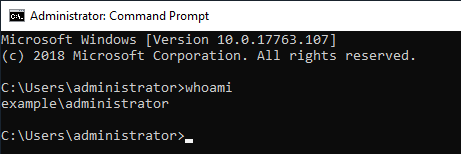
(1)Runas
First, change the account to Alice with the Runas command. (Alice account is a user of domain. Also, Alice account is included in Domain Admins.)

Entered Alice's password and RunAs succeeded.
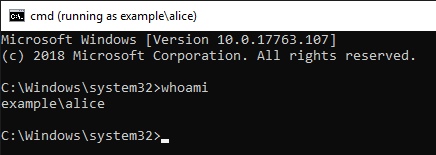
ID 4648 is recorded in the security log.

What happens if the authentication fails?

If the Runas command was not successful, I could not find ID 4648 in the security log.
(2)Overpass-the-Hash
Execute Overpass-the-Hash using Alice's NTLM hash value. ID 4648 has not occurred in this operation.
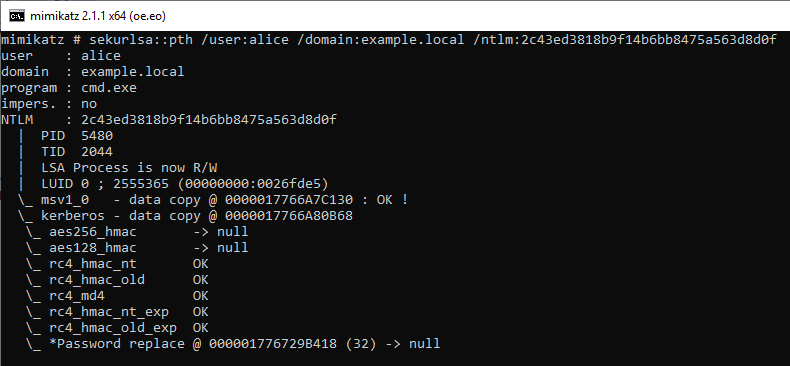
Execute the DIR command on the PtH CMD. By this operation, ID 4648 is recorded in the security log of PC1.
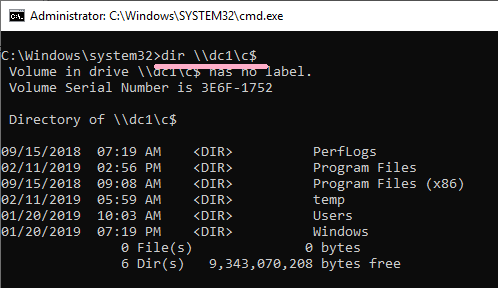

Connect to DC1 using the wrong hash value.
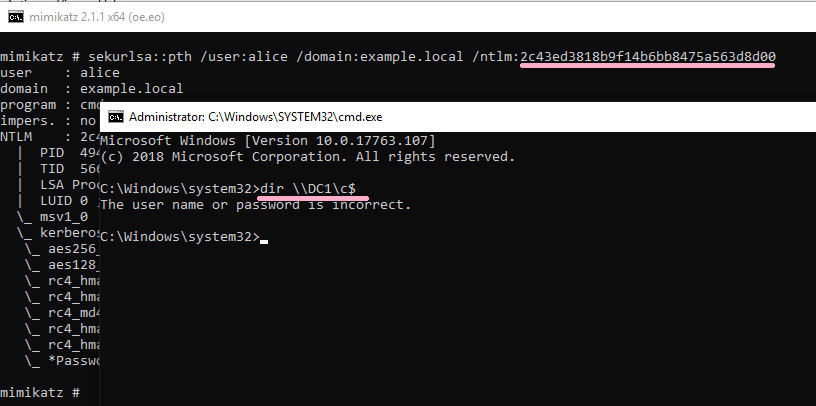
DIR command failed, but the ID 4648 was recorded.
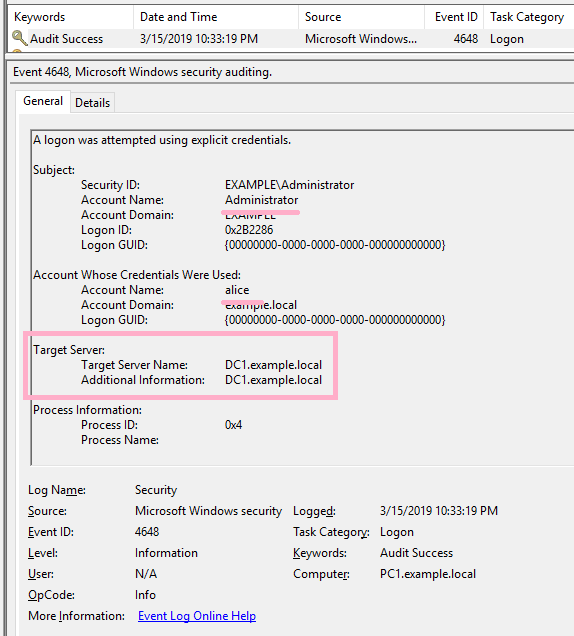
(3)NET USE
I started Administrator's CMD newly and executed the NET USE command. Specify Alice account with /user option. (The command line specifies the computer name. Kerberos authentication is used.)
ID 4648 is recorded in the security log of PC1.
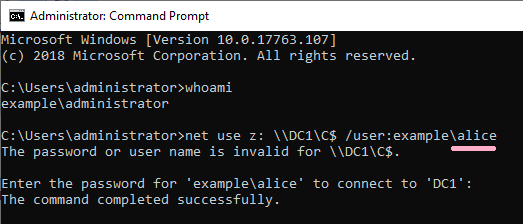

If the command was not successful, I could not find ID 4648 in the security log.
However, if you specify an IP address other than computer name, ID 4648 will be recorded.

(4)Task Scheduler(schtasks)
Use the schtasks command to register a job on the remote system.
(I got an error a little ;-)

ID 4648 is recorded in the security log of PC1. The contents of "Additional Information" is "host/DC1".
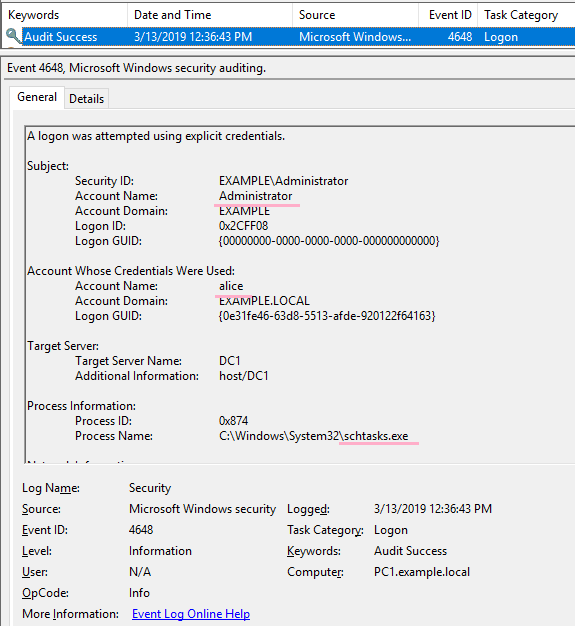
If the command was not successful, I could not find ID 4648 in the security log.

If you specify an IP address and authentication fails, ID 4648 will be recorded.

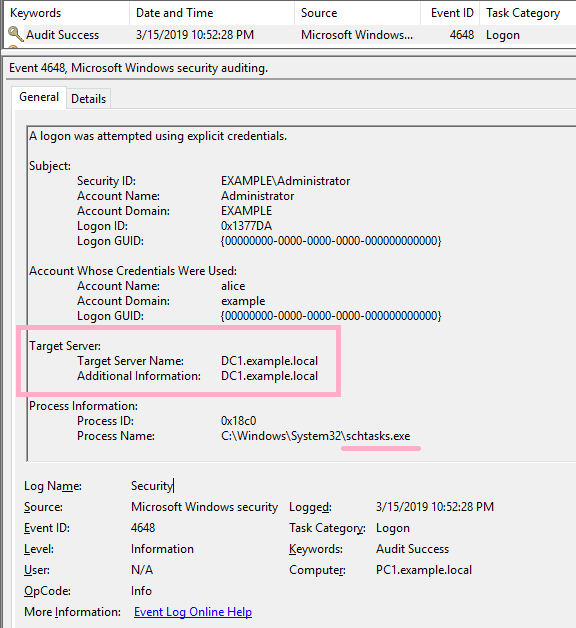
(5)PsExec
Execute ipconfig command on DC1 using PsExec command. Specify Alice account with -u option.
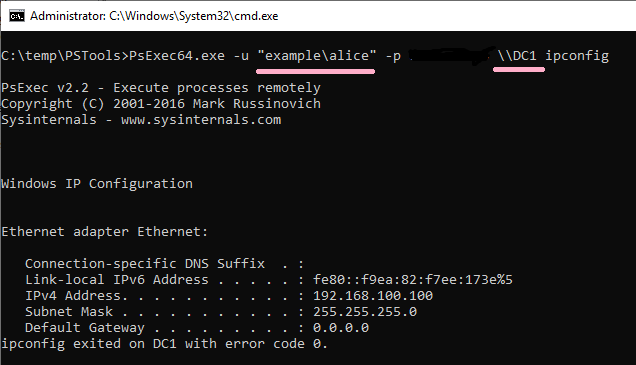
ID 4648 is recorded in the security log of PC1. The contents of "Additional Information" is "cifs/DC1".
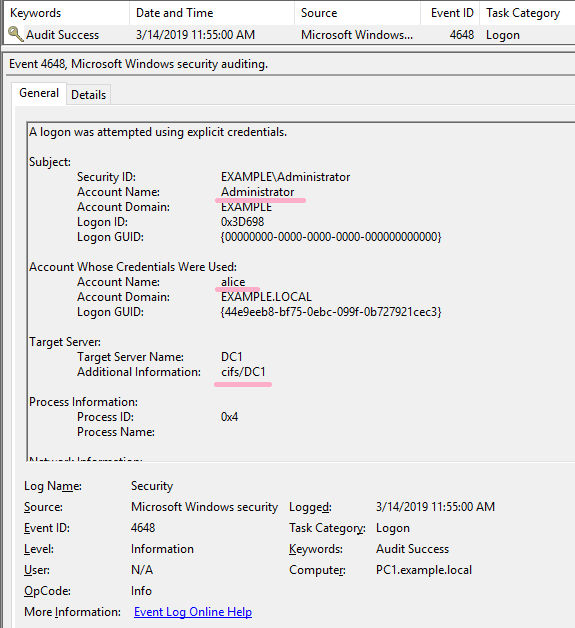
If the command was not successful, I could not find ID 4648 in the security log.
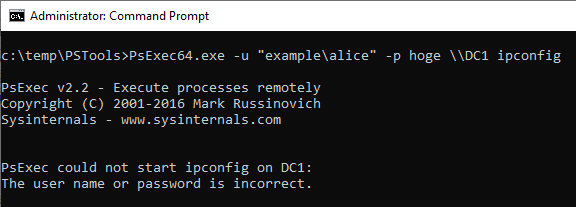
If you specify an IP address and authentication fails, ID 4648 will be recorded.
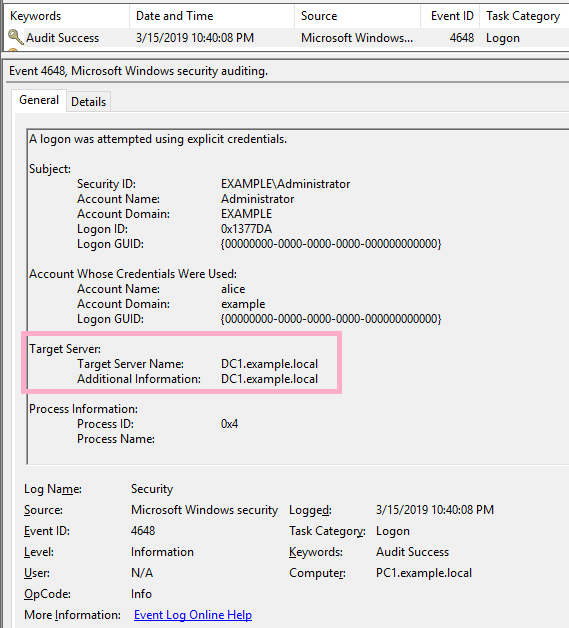
(6)WMIC
Execute ipconfig command on DC1 using WMIC command. Specify Alice account with /user option.

ID 4648 is recorded in the security log of PC1. The contents of "Additional Information" is "RestrictedKrbHost/DC1".


If the command was not successful, I could not find ID 4648 in the security log.

If you specify an IP address and authentication fails, ID 4648 was not recorded.

(7)PowerShell
Execute Powershell and Enter-PSSession. Specify Alice account with -Credential option.

ID 4648 is recorded in the security log of PC1. The contents of "Additional Information" is "HTTP/DC1".
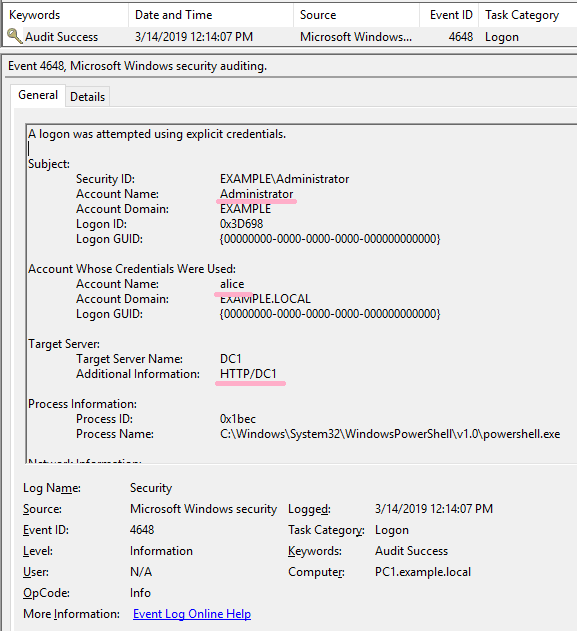
If the command was not successful, I could not find ID 4648 in the security log.

If you specify an IP address and authentication fails, ID 4648 was not recorded.

(8)Remote Desktop(mstsc)
Execute mstsc command. Specify Alice account.
(NLA is enabled on DC1.)
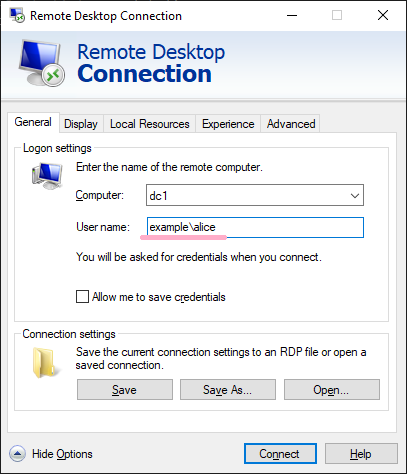
ID 4648 is recorded in the security log of PC1. The contents of "Additional Information" is "TERMSRV/dc1".
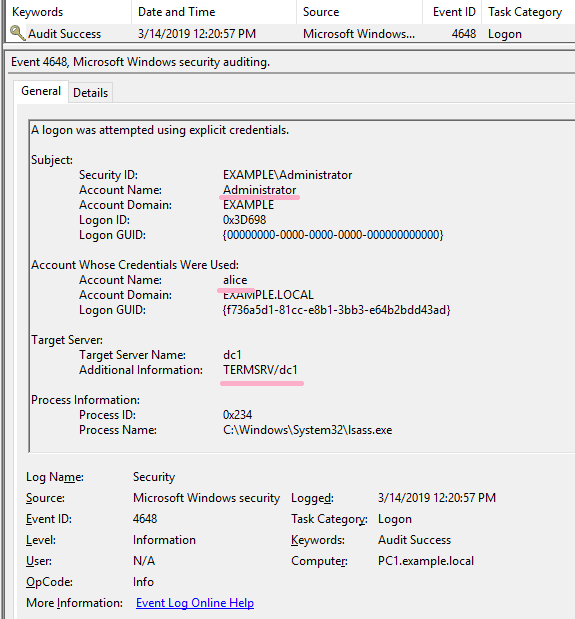
If the connection was not successful, I could not find ID 4648 in the security log.
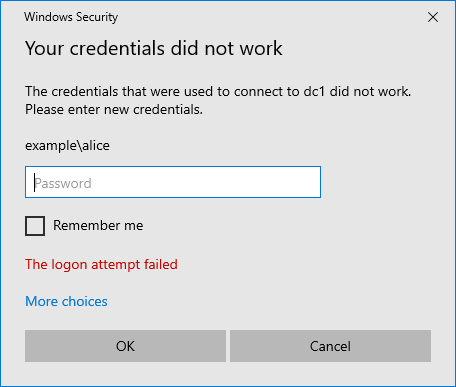
If you specified an IP address as the computer name, ID 4648 was recorded in the security log even if authentication failed.

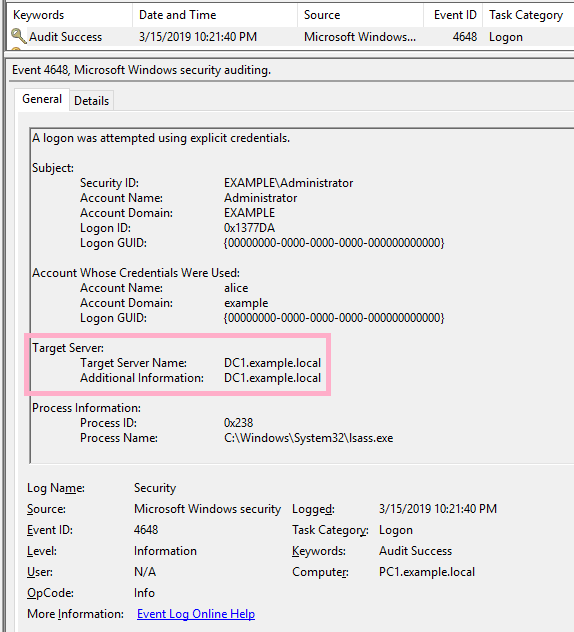
The details of RDP and ID 4648 are described in "Event Log Analysis" of IIJ-SECT.
It also explains the case where ID 4648 is not recorded when using "Restricted Admin mode". Please refer to the following URL.
https://sect.iij.ad.jp/d/2018/05/044132/training_material_sample_for_eventlog_analysis.pdf
Verification environment: Windows Server 2019 1809, Windows 10 1809, Time zone UTC
Reference URL:
[Lateral Movement - RPC over TCP/IP] - can be hunted using only 4648 (usually available) with Additional Information pointing to RPCSS SPN. #ThreatHunting #DFIR pic.twitter.com/7xsOcildbz
— MENASecurity (@menasec1) March 18, 2019
https://sect.iij.ad.jp/d/2018/05/044132/training_material_sample_for_eventlog_analysis.pdf

Active Directory and ADTimeline(5)
Note:I translated Japanese into English using Google Translate.
Thank you, Google.
Summary:
- Grant the access right of "AdminSDHolder" to Bob account, using DCshadow.
The nTSecurityDescriptor of "AdminSDHolder" is recorded in the ADTimeline. - The process of SDProp updates the access rights such as "Domain Admins" etc...These ACLs will now include Bob accounts.
----------
[Note]Please be aware that the verification method not be sufficient.
I will Check the ADTimeline of the case where changed the ACL of AdminSDHolder with DCshadow. DCshadow was executed with reference to the following URL.
Check the ACL before running DCshadow. Bob account does not have permissions for this folder. (Bob account does not have high privilege.)

Run DCshadow and grant access to Bob account. You can confirm that the access right of the Bob account has been added.


Check the ADTimeline. NT-Security-Descriptor attribute changes and "dwVersion" value is "2".
ftimeLastOriginatingChange : 2019-03-11T07:27:01Z
Name : AdminSDHolder
pszAttributeName : nTSecurityDescriptor
ObjectClass : container
DN : CN=AdminSDHolder,CN=System,DC=example,DC=local
ObjectCategory : CN=Container,CN=Schema,CN=Configuration,DC=example,DC=local
SamAccountName :
dwVersion : 2
WhenCreated : 2019-01-20 19:19:55Z
Member :
ftimeCreated :
ftimeDeleted :
SID :
pszLastOriginatingDsaDN :
uuidLastOriginatingDsaInvocationID : d5bc3667-ea75-4e13-a074-70f751b5e55c
usnOriginatingChange : 41052
usnLocalChange : 65687
"ADobjects.xml" file contains detailed information of AdminSDHolder. I can check the ACL added to Bob account.

Wait for execution of SDProp processing.
I can check the records related to ACL change of AdminSDHolder on the ADTimeline.
Display the ACL of the Domain Admins group, Bob has full control. (also in "ADobjects.xml" file.)

PS
I checked the status of adminCount in Bob account. the "adminCount" value of the Bob account is not set.

Verification environment: Windows Server 2019 1809, Windows 10 1809, Time zone UTC
Reference URL:
www.labofapenetrationtester.com

Active Directory and ADTimeline(4)
Note:I translated Japanese into English using Google Translate.
Thank you, Google.
Summary:
- Delete the Bob account. I can check the change of isDeleted on the ADTimeline.
- Activate the AD recycle bin and delete the Bob account. The changing attributes are different. "isRecycled" is not set.
----------
[Note]Please be aware that the verification method not be sufficient.
Last week I confirmed the traces of DCShadow on the timeline. PC1 was temporarily registered as DC by DCshadow and deleted immediately after that.
Today, I would like to delete the user account Bob. (AD Recycle Bin is disabled in the test environment.)
The Bob account has the SIDHsitory value set.

Delete the Bob account from the administration tool. (Unfortunately, I do not know if I can use DCshdow to delete user accounts.)

The Bob account has been deleted. 3/3/2019 11:10:29 AM

Check the ADTimeline. Multiple records are recorded at the time when the Bob account was deleted.

You can check the change of "isDeleted" attribute on the timeline.
ftimeLastOriginatingChange : 2019-03-03T11:10:29Z
Name : bob
DEL:c3027aff-3453-4894-bf89-f69a4fbb5e76
pszAttributeName : isDeleted
ObjectClass : user
DN : CN=bob\0ADEL:c3027aff-3453-4894-bf89-f69a4fbb5e76,CN=Deleted
Objects,DC=example,DC=local
ObjectCategory :
SamAccountName : bob
dwVersion : 1
WhenCreated : 2019-02-11 07:06:37Z
Member :
ftimeCreated :
ftimeDeleted :
SID : S-1-5-21-1490397982-2793378994-64436834-1601
pszLastOriginatingDsaDN : CN=NTDS Settings,CN=DC1,CN=Servers,CN=Default-First-Site-Name,CN=Sites,CN=Configur
ation,DC=example,DC=local
uuidLastOriginatingDsaInvocationID : c9e22352-ca47-436a-aeb2-38228298896d
usnOriginatingChange : 61506
usnLocalChange : 61506
In the "ADobjects.xml" file, check the Bob account information. It is interesting that "isRecycled" attribute is set to True. (this object has been marked for permanent deletion)
<Obj RefId="165">
<TNRef RefId="0" />
<ToString>CN=bob\0ADEL:c3027aff-3453-4894-bf89-f69a4fbb5e76,CN=Deleted Objects,DC=example,DC=local</ToString>
<Props>
<S N="CanonicalName">example.local/Deleted Objects/bob_x000A_DEL:c3027aff-3453-4894-bf89-f69a4fbb5e76</S>
<S N="CN">bob_x000A_DEL:c3027aff-3453-4894-bf89-f69a4fbb5e76</S>
<B N="Deleted">true</B>
<Nil N="Description" />
<Nil N="DisplayName" />
<S N="DistinguishedName">CN=bob\0ADEL:c3027aff-3453-4894-bf89-f69a4fbb5e76,CN=Deleted Objects,DC=example,DC=local</S>
<I32 N="instanceType">4</I32>
<B N="isDeleted">true</B>
<B N="isRecycled">true</B>
<S N="LastKnownParent">CN=Users,DC=example,DC=local</S>
<DT N="Modified">2019-03-03T11:10:29+00:00</DT>
<DT N="modifyTimeStamp">2019-03-03T11:10:29+00:00</DT>
<S N="Name">bob_x000A_DEL:c3027aff-3453-4894-bf89-f69a4fbb5e76</S>
<Nil N="ObjectCategory" />
<S N="ObjectClass">user</S>
<G N="ObjectGUID">c3027aff-3453-4894-bf89-f69a4fbb5e76</G>
<Obj N="objectSid" RefId="166">
<TNRef RefId="4" />
<ToString>S-1-5-21-1490397982-2793378994-64436834-1601</ToString>
<Props>
<I32 N="BinaryLength">28</I32>
<S N="AccountDomainSid">S-1-5-21-1490397982-2793378994-64436834</S>
<S N="Value">S-1-5-21-1490397982-2793378994-64436834-1601</S>
</Props>
</Obj>
<B N="ProtectedFromAccidentalDeletion">false</B>
<S N="sAMAccountName">bob</S>
<I32 N="sDRightsEffective">15</I32>
<I32 N="userAccountControl">66048</I32>
<I64 N="uSNChanged">61506</I64>
<I64 N="uSNCreated">36953</I64>
<DT N="whenChanged">2019-03-03T11:10:29+00:00</DT>
<DT N="whenCreated">2019-02-11T07:06:37+00:00</DT>
</Props>
</Obj>
Check the "SIDHsitory" item in "log-adexport.log".
2019-03-03 11:13:25 Number of accounts with SIDHistory in the forest: 0
The Bob account has been deleted, but if go back in the timeline I can track changes in SIDHistory etc.
I tried to Enable AD Recycle Bin, and encountered an error. I need time to investigate this error. :-(
I restored the snapshot of the test environment.


Delete the Bob account again and check the timeline. 3/3/2019 12:29:41 PM

The number of records differs from when deleting Bob account earlier.

Interestingly, I can not find the attribute "isRecycled". For the isRecycled attribute when the Recycle Bin is enabled, the description is written at Microsoft's URL.
<Obj RefId="165">
<TNRef RefId="0" />
<ToString>CN=bob\0ADEL:c3027aff-3453-4894-bf89-f69a4fbb5e76,CN=Deleted Objects,DC=example,DC=local</ToString>
<Props>
<S N="CanonicalName">example.local/Deleted Objects/bob_x000A_DEL:c3027aff-3453-4894-bf89-f69a4fbb5e76</S>
<S N="CN">bob_x000A_DEL:c3027aff-3453-4894-bf89-f69a4fbb5e76</S>
<B N="Deleted">true</B>
<Nil N="Description" />
<S N="DisplayName">bob</S>
<S N="DistinguishedName">CN=bob\0ADEL:c3027aff-3453-4894-bf89-f69a4fbb5e76,CN=Deleted Objects,DC=example,DC=local</S>
<I32 N="instanceType">4</I32>
<B N="isDeleted">true</B>
<S N="LastKnownParent">CN=Users,DC=example,DC=local</S>
<DT N="Modified">2019-03-03T12:29:41+00:00</DT>
<DT N="modifyTimeStamp">2019-03-03T12:29:41+00:00</DT>
<S N="Name">bob_x000A_DEL:c3027aff-3453-4894-bf89-f69a4fbb5e76</S>
<Nil N="ObjectCategory" />
<S N="ObjectClass">user</S>
<G N="ObjectGUID">c3027aff-3453-4894-bf89-f69a4fbb5e76</G>
<Obj N="objectSid" RefId="166">
<TNRef RefId="4" />
<ToString>S-1-5-21-1490397982-2793378994-64436834-1601</ToString>
<Props>
<I32 N="BinaryLength">28</I32>
<S N="AccountDomainSid">S-1-5-21-1490397982-2793378994-64436834</S>
<S N="Value">S-1-5-21-1490397982-2793378994-64436834-1601</S>
</Props>
</Obj>
<B N="ProtectedFromAccidentalDeletion">false</B>
<S N="sAMAccountName">bob</S>
<I32 N="sDRightsEffective">15</I32>
<I32 N="userAccountControl">66048</I32>
<I64 N="uSNChanged">61509</I64>
<I64 N="uSNCreated">36953</I64>
<DT N="whenChanged">2019-03-03T12:29:41+00:00</DT>
<DT N="whenCreated">2019-02-11T07:06:37+00:00</DT>
</Props>
</Obj>
<ADD 2019/3/6>
Restore the Bob account from the Recycle Bin.

The SIDHistory value of the Bob account has also been restored.

Check the ADTimeline. You can find several records related to Bob account restore.

Check the Bob account information in the ADobjects.xml file. A lot of interesting information was displayed.
<Obj RefId="165">
<TNRef RefId="0" />
<ToString>CN=bob,CN=Users,DC=example,DC=local</ToString>
<Props>
<I64 N="accountExpires">9223372036854775807</I64>
<S N="CanonicalName">example.local/Users/bob</S>
<S N="CN">bob</S>
<I32 N="codePage">0</I32>
<I32 N="countryCode">0</I32>
<DT N="Created">2019-02-11T07:06:37+00:00</DT>
<DT N="createTimeStamp">2019-02-11T07:06:37+00:00</DT>
<Nil N="Deleted" />
<Nil N="Description" />
<S N="DisplayName">bob</S>
<S N="DistinguishedName">CN=bob,CN=Users,DC=example,DC=local</S>
<Obj N="dSCorePropagationData" RefId="166">
<TNRef RefId="1" />
<LST>
<DT>2019-03-06T11:36:40+00:00</DT>
<DT>1601-01-01T00:00:00+00:00</DT>
</LST>
</Obj>
<S N="givenName">bob</S>
<I32 N="instanceType">4</I32>
<Nil N="isDeleted" />
<S N="LastKnownParent">CN=Users,DC=example,DC=local</S>
<I64 N="lastLogonTimestamp">131953593229547103</I64>
<DT N="Modified">2019-03-06T11:36:40+00:00</DT>
<DT N="modifyTimeStamp">2019-03-06T11:36:40+00:00</DT>
<S N="msDS-LastKnownRDN">bob</S>
<S N="Name">bob</S>
<Obj N="nTSecurityDescriptor" RefId="167">
<TNRef RefId="2" />
<ToString>System.DirectoryServices.ActiveDirectorySecurity</ToString>
<Props>
<S N="AccessRightType">System.DirectoryServices.ActiveDirectoryRights</S>
<S N="AccessRuleType">System.DirectoryServices.ActiveDirectoryAccessRule</S>
<S N="AuditRuleType">System.DirectoryServices.ActiveDirectoryAuditRule</S>
<B N="AreAccessRulesProtected">false</B>
<B N="AreAuditRulesProtected">false</B>
<B N="AreAccessRulesCanonical">true</B>
<B N="AreAuditRulesCanonical">true</B>
</Props>
<MS>
<S N="Owner">EXAMPLE\Domain Admins</S>
<S N="Group">EXAMPLE\Domain Admins</S>
<Obj N="Access" RefId="168">
<TNRef RefId="3" />
<IE>
<S>System.DirectoryServices.ActiveDirectoryAccessRule</S>
<S>System.DirectoryServices.ActiveDirectoryAccessRule</S>
<S>System.DirectoryServices.ActiveDirectoryAccessRule</S>
<S>System.DirectoryServices.ActiveDirectoryAccessRule</S>
<S>System.DirectoryServices.ActiveDirectoryAccessRule</S>
<S>System.DirectoryServices.ActiveDirectoryAccessRule</S>
<S>System.DirectoryServices.ActiveDirectoryAccessRule</S>
<S>System.DirectoryServices.ActiveDirectoryAccessRule</S>
<S>System.DirectoryServices.ActiveDirectoryAccessRule</S>
<S>System.DirectoryServices.ActiveDirectoryAccessRule</S>
<S>System.DirectoryServices.ActiveDirectoryAccessRule</S>
<S>System.DirectoryServices.ActiveDirectoryAccessRule</S>
<S>System.DirectoryServices.ActiveDirectoryAccessRule</S>
<S>System.DirectoryServices.ActiveDirectoryAccessRule</S>
<S>System.DirectoryServices.ActiveDirectoryAccessRule</S>
<S>System.DirectoryServices.ActiveDirectoryAccessRule</S>
<S>System.DirectoryServices.ActiveDirectoryAccessRule</S>
<S>System.DirectoryServices.ActiveDirectoryAccessRule</S>
<S>System.DirectoryServices.ActiveDirectoryAccessRule</S>
<S>System.DirectoryServices.ActiveDirectoryAccessRule</S>
<S>System.DirectoryServices.ActiveDirectoryAccessRule</S>
<S>System.DirectoryServices.ActiveDirectoryAccessRule</S>
<S>System.DirectoryServices.ActiveDirectoryAccessRule</S>
<S>System.DirectoryServices.ActiveDirectoryAccessRule</S>
<S>System.DirectoryServices.ActiveDirectoryAccessRule</S>
<S>System.DirectoryServices.ActiveDirectoryAccessRule</S>
<S>System.DirectoryServices.ActiveDirectoryAccessRule</S>
<S>System.DirectoryServices.ActiveDirectoryAccessRule</S>
<S>System.DirectoryServices.ActiveDirectoryAccessRule</S>
<S>System.DirectoryServices.ActiveDirectoryAccessRule</S>
<S>System.DirectoryServices.ActiveDirectoryAccessRule</S>
<S>System.DirectoryServices.ActiveDirectoryAccessRule</S>
<S>System.DirectoryServices.ActiveDirectoryAccessRule</S>
<S>System.DirectoryServices.ActiveDirectoryAccessRule</S>
<S>System.DirectoryServices.ActiveDirectoryAccessRule</S>
<S>System.DirectoryServices.ActiveDirectoryAccessRule</S>
<S>System.DirectoryServices.ActiveDirectoryAccessRule</S>
<S>System.DirectoryServices.ActiveDirectoryAccessRule</S>
<S>System.DirectoryServices.ActiveDirectoryAccessRule</S>
<S>System.DirectoryServices.ActiveDirectoryAccessRule</S>
<S>System.DirectoryServices.ActiveDirectoryAccessRule</S>
<S>System.DirectoryServices.ActiveDirectoryAccessRule</S>
<S>System.DirectoryServices.ActiveDirectoryAccessRule</S>
<S>System.DirectoryServices.ActiveDirectoryAccessRule</S>
<S>System.DirectoryServices.ActiveDirectoryAccessRule</S>
<S>System.DirectoryServices.ActiveDirectoryAccessRule</S>
<S>System.DirectoryServices.ActiveDirectoryAccessRule</S>
<S>System.DirectoryServices.ActiveDirectoryAccessRule</S>
<S>System.DirectoryServices.ActiveDirectoryAccessRule</S>
<S>System.DirectoryServices.ActiveDirectoryAccessRule</S>
</IE>
</Obj>
<S N="Sddl">O:DAG:DAD:AI(A;;LCRPLORC;;;PS)(A;;RC;;;AU)(A;;CCDCLCSWRPWPDTLOCRSDRCWDWO;;;SY)(A;;CCDCLCSWRPWPDTLOCRSDRCWDWO;;;AO)(A;;CCDCLCSWRPWPDTLOCRSDRCWDWO;;;DA)(OA;;CR;ab721a53-1e2f-11d0-9819-00aa0040529b;;WD)(OA;;RPWP;e45795b2-9455-11d1-aebd-0000f80367c1;;PS)(OA;;RPWP;77b5b886-944a-11d1-aebd-0000f80367c1;;PS)(OA;;RPWP;e45795b3-9455-11d1-aebd-0000f80367c1;;PS)(OA;;CR;ab721a53-1e2f-11d0-9819-00aa0040529b;;PS)(OA;;CR;ab721a54-1e2f-11d0-9819-00aa0040529b;;PS)(OA;;CR;ab721a56-1e2f-11d0-9819-00aa0040529b;;PS)(OA;;RP;59ba2f42-79a2-11d0-9020-00c04fc2d3cf;;AU)(OA;;RP;e48d0154-bcf8-11d1-8702-00c04fb96050;;AU)(OA;;RP;77b5b886-944a-11d1-aebd-0000f80367c1;;AU)(OA;;RP;e45795b3-9455-11d1-aebd-0000f80367c1;;AU)(OA;;RP;46a9b11d-60ae-405a-b7e8-ff8a58d456d2;;S-1-5-32-560)(OA;;RPWP;5805bc62-bdc9-4428-a5e2-856a0f4c185e;;S-1-5-32-561)(OA;;RPWP;6db69a1c-9422-11d1-aebd-0000f80367c1;;S-1-5-32-561)(OA;;RPWP;bf967a7f-0de6-11d0-a285-00aa003049e2;;CA)(OA;;RP;037088f8-0ae1-11d2-b422-00a0c968f939;;RS)(OA;;RP;bc0ac240-79a9-11d0-9020-00c04fc2d4cf;;RS)(OA;;RP;5f202010-79a5-11d0-9020-00c04fc2d4cf;;RS)(OA;;RP;4c164200-20c0-11d0-a768-00aa006e0529;;RS)(OA;CIIOID;RP;4c164200-20c0-11d0-a768-00aa006e0529;4828cc14-1437-45bc-9b07-ad6f015e5f28;RU)(OA;CIID;RP;4c164200-20c0-11d0-a768-00aa006e0529;bf967aba-0de6-11d0-a285-00aa003049e2;RU)(OA;CIIOID;RP;5f202010-79a5-11d0-9020-00c04fc2d4cf;4828cc14-1437-45bc-9b07-ad6f015e5f28;RU)(OA;CIID;RP;5f202010-79a5-11d0-9020-00c04fc2d4cf;bf967aba-0de6-11d0-a285-00aa003049e2;RU)(OA;CIIOID;RP;bc0ac240-79a9-11d0-9020-00c04fc2d4cf;4828cc14-1437-45bc-9b07-ad6f015e5f28;RU)(OA;CIID;RP;bc0ac240-79a9-11d0-9020-00c04fc2d4cf;bf967aba-0de6-11d0-a285-00aa003049e2;RU)(OA;CIIOID;RP;59ba2f42-79a2-11d0-9020-00c04fc2d3cf;4828cc14-1437-45bc-9b07-ad6f015e5f28;RU)(OA;CIID;RP;59ba2f42-79a2-11d0-9020-00c04fc2d3cf;bf967aba-0de6-11d0-a285-00aa003049e2;RU)(OA;CIIOID;RP;037088f8-0ae1-11d2-b422-00a0c968f939;4828cc14-1437-45bc-9b07-ad6f015e5f28;RU)(OA;CIID;RP;037088f8-0ae1-11d2-b422-00a0c968f939;bf967aba-0de6-11d0-a285-00aa003049e2;RU)(OA;CIID;RPWP;5b47d60f-6090-40b2-9f37-2a4de88f3063;;S-1-5-21-1490397982-2793378994-64436834-526)(OA;CIID;RPWP;5b47d60f-6090-40b2-9f37-2a4de88f3063;;S-1-5-21-1490397982-2793378994-64436834-527)(OA;CIIOID;SW;9b026da6-0d3c-465c-8bee-5199d7165cba;bf967a86-0de6-11d0-a285-00aa003049e2;CO)(OA;CIIOID;SW;9b026da6-0d3c-465c-8bee-5199d7165cba;bf967a86-0de6-11d0-a285-00aa003049e2;PS)(OA;CIIOID;RP;b7c69e6d-2cc7-11d2-854e-00a0c983f608;bf967a86-0de6-11d0-a285-00aa003049e2;ED)(OA;CIIOID;RP;b7c69e6d-2cc7-11d2-854e-00a0c983f608;bf967a9c-0de6-11d0-a285-00aa003049e2;ED)(OA;CIID;RP;b7c69e6d-2cc7-11d2-854e-00a0c983f608;bf967aba-0de6-11d0-a285-00aa003049e2;ED)(OA;CIIOID;WP;ea1b7b93-5e48-46d5-bc6c-4df4fda78a35;bf967a86-0de6-11d0-a285-00aa003049e2;PS)(OA;CIIOID;LCRPLORC;;4828cc14-1437-45bc-9b07-ad6f015e5f28;RU)(OA;CIIOID;LCRPLORC;;bf967a9c-0de6-11d0-a285-00aa003049e2;RU)(OA;CIID;LCRPLORC;;bf967aba-0de6-11d0-a285-00aa003049e2;RU)(OA;OICIID;RPWP;3f78c3e5-f79a-46bd-a0b8-9d18116ddc79;;PS)(OA;CIID;RPWPCR;91e647de-d96f-4b70-9557-d63ff4f3ccd8;;PS)(A;CIID;CCDCLCSWRPWPDTLOCRSDRCWDWO;;;S-1-5-21-1490397982-2793378994-64436834-519)(A;CIID;LC;;;RU)(A;CIID;CCLCSWRPWPLOCRSDRCWDWO;;;BA)</S>
<S N="AccessToString">NT AUTHORITY\SELF Allow _x000A_NT AUTHORITY\Authenticated Users Allow _x000A_NT AUTHORITY\SYSTEM Allow _x000A_BUILTIN\Account Operators Allow _x000A_EXAMPLE\Domain Admins Allow _x000A_Everyone Allow _x000A_NT AUTHORITY\SELF Allow _x000A_NT AUTHORITY\SELF Allow _x000A_NT AUTHORITY\SELF Allow _x000A_NT AUTHORITY\SELF Allow _x000A_NT AUTHORITY\SELF Allow _x000A_NT AUTHORITY\SELF Allow _x000A_NT AUTHORITY\Authenticated Users Allow _x000A_NT AUTHORITY\Authenticated Users Allow _x000A_NT AUTHORITY\Authenticated Users Allow _x000A_NT AUTHORITY\Authenticated Users Allow _x000A_BUILTIN\Windows Authorization Access Group Allow _x000A_BUILTIN\Terminal Server License Servers Allow _x000A_BUILTIN\Terminal Server License Servers Allow _x000A_EXAMPLE\Cert Publishers Allow _x000A_EXAMPLE\RAS and IAS Servers Allow _x000A_EXAMPLE\RAS and IAS Servers Allow _x000A_EXAMPLE\RAS and IAS Servers Allow _x000A_EXAMPLE\RAS and IAS Servers Allow _x000A_BUILTIN\Pre-Windows 2000 Compatible Access Allow _x000A_BUILTIN\Pre-Windows 2000 Compatible Access Allow _x000A_BUILTIN\Pre-Windows 2000 Compatible Access Allow _x000A_BUILTIN\Pre-Windows 2000 Compatible Access Allow _x000A_BUILTIN\Pre-Windows 2000 Compatible Access Allow _x000A_BUILTIN\Pre-Windows 2000 Compatible Access Allow _x000A_BUILTIN\Pre-Windows 2000 Compatible Access Allow _x000A_BUILTIN\Pre-Windows 2000 Compatible Access Allow _x000A_BUILTIN\Pre-Windows 2000 Compatible Access Allow _x000A_BUILTIN\Pre-Windows 2000 Compatible Access Allow _x000A_EXAMPLE\Key Admins Allow _x000A_EXAMPLE\Enterprise Key Admins Allow _x000A_CREATOR OWNER Allow _x000A_NT AUTHORITY\SELF Allow _x000A_NT AUTHORITY\ENTERPRISE DOMAIN CONTROLLERS Allow _x000A_NT AUTHORITY\ENTERPRISE DOMAIN CONTROLLERS Allow _x000A_NT AUTHORITY\ENTERPRISE DOMAIN CONTROLLERS Allow _x000A_NT AUTHORITY\SELF Allow _x000A_BUILTIN\Pre-Windows 2000 Compatible Access Allow _x000A_BUILTIN\Pre-Windows 2000 Compatible Access Allow _x000A_BUILTIN\Pre-Windows 2000 Compatible Access Allow _x000A_NT AUTHORITY\SELF Allow _x000A_NT AUTHORITY\SELF Allow _x000A_EXAMPLE\Enterprise Admins Allow _x000A_BUILTIN\Pre-Windows 2000 Compatible Access Allow _x000A_BUILTIN\Administrators Allow </S>
<S N="AuditToString"></S>
</MS>
</Obj>
<S N="ObjectCategory">CN=Person,CN=Schema,CN=Configuration,DC=example,DC=local</S>
<S N="ObjectClass">user</S>
<G N="ObjectGUID">c3027aff-3453-4894-bf89-f69a4fbb5e76</G>
<Obj N="objectSid" RefId="169">
<TNRef RefId="4" />
<ToString>S-1-5-21-1490397982-2793378994-64436834-1601</ToString>
<Props>
<I32 N="BinaryLength">28</I32>
<S N="AccountDomainSid">S-1-5-21-1490397982-2793378994-64436834</S>
<S N="Value">S-1-5-21-1490397982-2793378994-64436834-1601</S>
</Props>
</Obj>
<I32 N="primaryGroupID">513</I32>
<B N="ProtectedFromAccidentalDeletion">false</B>
<I64 N="pwdLastSet">131943423975962354</I64>
<S N="sAMAccountName">bob</S>
<I32 N="sAMAccountType">805306368</I32>
<I32 N="sDRightsEffective">15</I32>
<Obj N="sIDHistory" RefId="170">
<TNRef RefId="1" />
<LST>
<Obj RefId="171">
<TNRef RefId="4" />
<ToString>S-1-5-21-1490397982-2793378994-64436834-500</ToString>
<Props>
<I32 N="BinaryLength">28</I32>
<S N="AccountDomainSid">S-1-5-21-1490397982-2793378994-64436834</S>
<S N="Value">S-1-5-21-1490397982-2793378994-64436834-500</S>
</Props>
</Obj>
</LST>
</Obj>
<I32 N="userAccountControl">66048</I32>
<S N="userPrincipalName">bob@example.local</S>
<I64 N="uSNChanged">65610</I64>
<I64 N="uSNCreated">36953</I64>
<DT N="whenChanged">2019-03-06T11:36:40+00:00</DT>
<DT N="whenCreated">2019-02-11T07:06:37+00:00</DT>
</Props>
</Obj>
</ADD>
I will continue testing.
Verification environment: Windows Server 2019 1809, Windows 10 1809, Time zone UTC
Reference URL:

Active Directory and ADTimeline(3)
Note:I translated Japanese into English using Google Translate.
Thank you, Google.
Summary:
- I added the Bob account to the "Domain Admins" group and deleted it from the group. You can check this operation with ADTimeline.
- Run DCsync with Alice account. This operation could not be confirmed on the timeline.
- Using DCshadw, set the SIDHsitory of the Bob account. The operation by DCshadow can be confirmed with ADtimeline.
----------
[Note]Please be aware that the verification method not be sufficient.
I checked the ADTimeline about Bob account last week.(Last week, I was not reading "README.md" carefully.)
Bob account is a regular user, today's test I would like to set Bob high privilege. Add the Bob account to the Domain Admins group and then delete it from the group.

DC1: 2/23/2019 1:29:15 AM EID 4728 A member was added to a security-enabled global group.(Bob)

DC2: 2/23/2019 1:35:23 AM Log on to PC1 with Bob account
DC2: 2/23/2019 1:40:50 AM Bob account log off.
Since Bob was a Domain Admins group, it appears on the timeline. I can check the following records on ADtimeline.(I have not set up a custom group.)
ftimeLastOriginatingChange : 2019-02-23T01:35:22Z
Name : bob
pszAttributeName : lastLogonTimestamp
ObjectClass : user
DN : CN=bob,CN=Users,DC=example,DC=local
ObjectCategory : CN=Person,CN=Schema,CN=Configuration,DC=example,DC=local
SamAccountName : bob
dwVersion : 2
WhenCreated : 2019-02-11 07:06:37Z
Member :
ftimeCreated :
ftimeDeleted :
SID : S-1-5-21-1490397982-2793378994-64436834-1601
pszLastOriginatingDsaDN : CN=NTDS Settings,CN=DC2,CN=Servers,CN=Default-First-Site-Name,CN=Sites,CN=Configur
ation,DC=example,DC=local
uuidLastOriginatingDsaInvocationID : 97c9ab0f-143e-4218-96fb-a6bdc442af7e
usnOriginatingChange : 24760
usnLocalChange : 45216
Delete the Bob account from the Domain Admins group.
DC1: 2/23/2019 1:44:06 AM EID 4729 A member was removed from a security-enabled global group.(Bob)

On ADTimeline, I can check the date and time Bob was added and deleted to Domain Adminsin the following record.
ftimeLastOriginatingChange : 2019-02-23T01:44:06Z
Name : Domain Admins
pszAttributeName : member
ObjectClass : group
DN : CN=Domain Admins,CN=Users,DC=example,DC=local
ObjectCategory : CN=Group,CN=Schema,CN=Configuration,DC=example,DC=local
SamAccountName : Domain Admins
dwVersion : 2
WhenCreated : 2019-01-20 19:20:35Z
Member : CN=bob,CN=Users,DC=example,DC=local
ftimeCreated : 2019-02-23T01:29:15Z
ftimeDeleted : 2019-02-23T01:44:06Z
SID : S-1-5-21-1490397982-2793378994-64436834-512
pszLastOriginatingDsaDN : CN=NTDS Settings,CN=DC1,CN=Servers,CN=Default-First-Site-Name,CN=Sites,CN=Configur
ation,DC=example,DC=local
uuidLastOriginatingDsaInvocationID : c9e22352-ca47-436a-aeb2-38228298896d
usnOriginatingChange : 45230
usnLocalChange : 45230
Next test, I would like to grant high privilege by using Bob's SIDHistory.
Log on to PC1 with Alice account.Run Mimikatz on Alice account and check administrator's information using DCsync.

DC2: 2/23/2019 1:53:36 AM EID 4662 An operation was performed on an object.

On ADtimeline, I can confirm Alice 's logon, but I could not find a record related to DCSync. (I guess that metadata replication does not occur.)
Run DCshadow with the Alice account and set the Administrator's SID in the sidHistory of the Bob account.

DC2: 2/23/2019 2:12:15 AM EID 4662 An operation was performed on an object.

On the ADTimeline, I can confirm this operation with several records. "PC1" that operated DCshadow is displayed.
ftimeLastOriginatingChange : 2019-02-23T02:12:15Z
Name : PC1
DEL:de838231-3f87-47d4-b77f-8e3a546f2f31
pszAttributeName : dNSHostName
ObjectClass : server
DN : CN=PC1\0ADEL:de838231-3f87-47d4-b77f-8e3a546f2f31,CN=Servers,CN=Default-First-Site
-Name,CN=Sites,CN=Configuration,DC=example,DC=local
ObjectCategory :
SamAccountName :
dwVersion : 1
WhenCreated : 2019-02-23 02:12:15Z
Member :
ftimeCreated :
ftimeDeleted :
SID :
pszLastOriginatingDsaDN : CN=NTDS Settings,CN=DC2,CN=Servers,CN=Default-First-Site-Name,CN=Sites,CN=Configur
ation,DC=example,DC=local
uuidLastOriginatingDsaInvocationID : 97c9ab0f-143e-4218-96fb-a6bdc442af7e
usnOriginatingChange : 24859
usnLocalChange : 45319
<add>
I got a comment in DM. The following time stamps show the same value. Promotion and deletion of DC occurred at the same time.
ftimeLastOriginatingChange = WhenCreated
</add>
The "log-adexport.log" file contains the output related to DCshadow.I have failed to run DCshadow once, so it is recorded twice. ;-)
2019-02-23 02:31:30 Domain Controller demotion or use of DCShadow: 2 deleted server objects and 2 deleted nTDSDSA objects located in the tombstone
You can also check records related to Bob's SIDHistory with ADTimeline.
ftimeLastOriginatingChange : 2019-02-23T02:12:15Z
Name : bob
pszAttributeName : sIDHistory
ObjectClass : user
DN : CN=bob,CN=Users,DC=example,DC=local
ObjectCategory : CN=Person,CN=Schema,CN=Configuration,DC=example,DC=local
SamAccountName : bob
dwVersion : 1
WhenCreated : 2019-02-11 07:06:37Z
Member :
ftimeCreated :
ftimeDeleted :
SID : S-1-5-21-1490397982-2793378994-64436834-1601
pszLastOriginatingDsaDN :
uuidLastOriginatingDsaInvocationID : d5bc3667-ea75-4e13-a074-70f751b5e55c
usnOriginatingChange : 24822
usnLocalChange : 45335
The number of SIDHistory is output in the "log-adexport.log" file.
2019-02-23 02:31:30 Number of accounts with SIDHistory in the forest: 1
2019-02-23 02:31:30 Number of accounts with a suspicious SIDHistory in the current domain: 1
Let's check the properties of Bob account.
The SID of Administrator is set in SIDHistory of Bob account. On DC 2, the time stamp of whenChanged is "2/23/2019 2:12:15 AM".

On DC1, the time stamp of whenChanged is "2/23/2019 2:12:30 AM".(Whenchanged is not replicated.)

What is the change at 2:12:30? , I confirmed the event log but could not identify it.
You can download timeline and event log from here.
I will continue testing.
Verification environment: Windows Server 2019 1809, Windows 10 1809, Time zone UTC
Reference URL:
When-Changed attribute - Windows applications | Microsoft Docs
